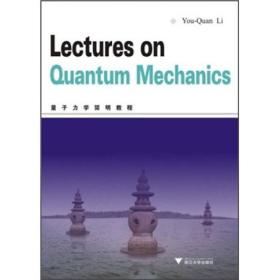
量子力学简明教程
¥ 27.09 7.1折 ¥ 38 九五品
仅1件
作者You-Quan Li
出版社浙江大学出版社
ISBN9787308079846
出版时间2010-12
版次1
装帧平装
开本16开
纸张胶版纸
页数229页
定价38元
上书时间2024-06-19
- 最新上架
商品详情
- 品相描述:九五品
- 商品描述
-
基本信息
书名:量子力学简明教程
定价:38.00元
作者:You-Quan Li
出版社:浙江大学出版社
出版日期:2010-12-01
ISBN:9787308079846
字数:
页码:229
版次:1
装帧:平装
开本:32开
商品重量:
编辑推荐
内容提要
This is based on the authorsfollowing two principles: (i) if a textbook were so perfectly arranged that leaves nothing to be desired, it would make the readers feel that the scientific discovery is so mystical that they lose passion of creativity.
目录
I Basic Concepts and Main Applicatio1 The Discovery of Quantum Theory1.1 Blackbody Radiation and Planck‘s Hypothesis of Energy Quanta1.2 Photoelectric Effect and Ei tein’s Hypothesis of Light Quanta1.3 The Atomic Spectra and Bohr‘s Model of Atoms2 Wavefunction and Schr6dinger Equatio2.1 The de Broglie Hypothesis and Davisson-Germer Experiment2.2 Schrodinger Equatio2.3 Stationary Solutio2.4 General Properties of Motion in One Dime io2.5 Bound States in Potential Well2.5.1 Square Well of Infinite Depth2.5.2 Square Well of Finite Depth2.6 The Harmonic Oscillator2.7 Tunnelling Effect3 Operato and Heisenberg Uncertainty Relatio3.1 Observables and Operato3.2 Hermitian Operato and Their Properties3.3 Some Example Operato3.3.1 Momentum Operato and Their Eigenfunctio3.3.2 Angular Momentum Operato and Their Eigenfunctio3.3.3 Coordinate Representation and Momentum Representatio3.4 Evaluation of the Expectation Values3.5 The Heisenberg Uncertainty Relatio3.5.1 Commutation Relatio and Their Implicatio3.5.2 Uncertainty Relation and the Minimum Uncertainty State3.6 The Time Evolution of Expectation Values4 Motion in a Centrally Symmetric Field4.1 Three Dime ional Harmonic Oscillato4.2 The Feature of Motion in a Centrally Symmetric Field4.3 Spherical Waves and Plane Waves4.4 Motion in a Coulomb Field4.5 Hydrogen-like Energy Levels4.6 Hydrogen Atom and Hydrogen-like Io5 States and Heisenberg Equatio5.1 Matrix Representation of Operato5.2 States and Their Representatio5.3 The Heisenberg Equatio5.4 Algebraic Approach for Harmonic Oscillator5.5 Algebraic Approach for Angular MomentumII Developing Skills6 Bound-State Perturbation and Correctio to Energy Levels6.1 Nondegenerate Perturbation TheOry6.2 Degenerate Perturbation Theory6.3 Stark Effect7 Time-dependent Perturbation and Quantum Tra itio7.1 Perturbation Depending on Time7.2 Tra ition Probability7.2.1 Periodic Perturbation of Single Frequency7.2.2 Tra ition to Continuous Spectrum7.3 Induced Absorption and Emissio7.4 Ei tein’s Semi-phenomenological Theory for Spontaneous Emissio8 Scattering Theory for Elastic Collisio8.1 Scattering Amplitude and Cross Sectio8.2 Born Appromatio8.2.1 The Simplest Approach8.2.2 Lippmann-Schwinger Equatio8.2.3 Scattering by Screened Coulomb Potential8.3 Partial-Wave Approach8.3.1 Phase Shifts and Scattering Amplitudes for Centrally Symmetric Potentials8.3.2 Neutron-Proton Scattering8.3.3 The Center-of-Mass Frame and the Lab Frame9 Motion in a Magnetic Field9.1 Schrodinger Equation for a Charged Particle in Electromagnetic Fields9.2 Electro in a Uniform Magnetic Field9.3 Atoms in Magnetic Field and Zeeman Effect9.4 Electron Spi9.5 Spin-Orbit Coupling and the Fine Structure of Atomic Spectra9.5.1 On Spin-Orbit Coupling9.5.2 On the Fine Structure of Atomic Spectra10 Identical Particles and Pauli Exclusive Principle10.1 Permutation Symmetry and the Indistinguishability of Identical Particles10.2 Noninteracting Systems,Pauli Exclusive Principle10.2.1 Two-particle Systems10.2.2 N-particle Systems10.3 Interacting Systems10.3.1 Helium Atom,Hund‘s RuleA Matrix and Vector SpaceB δ-functioC Confluent Hypergeometric FunctioD Orbitals for d-ElectroE Lab Frame and Center-of-mass FrameF On an IntegralG Time Reve al and Krame Degeneracy
作者介绍
序言
-

【封面】
相关推荐
— 没有更多了 —


















以下为对购买帮助不大的评价